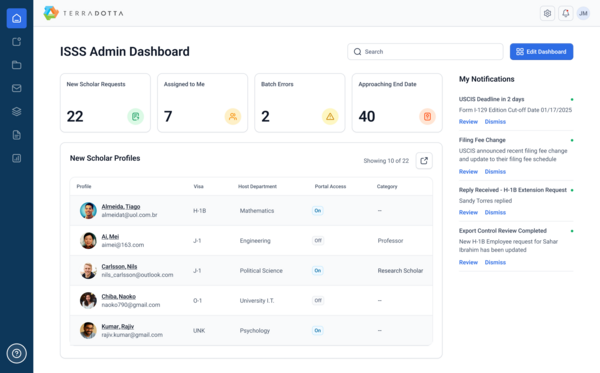You have /5 articles left.
Sign up for a free account or log in.

International students must meet a variety of compliance requirements to maintain legal standing in the U.S., and recent policy changes have made requirements more difficult to navigate.
miniseries/E+/Getty Images
Managing international student enrollment and retention requires significant attention to detail, as students and institutions juggle compliance, data reporting and other regulatory concerns. Cracks in the system came to a head in April when the federal government began changing students’ SEVIS statuses without warning, threatening their legal standing in the U.S. for unclear reasons.
For weeks, international student services providers would log into the Student and Exchange Visitor Information System, managed by the Department of State, twice a day, logging any changes made to student statuses. A lack of clear communication or warnings of the changes compounded the challenges of keeping track.
Since then, the government has restored thousands of students SEVIS’ statuses, but new policies are targeting additional student populations, including recent graduates on Optional Practical Training and students from China. The constantly evolving landscape has threatened international students’ enrollment and persistence and continues to cause headaches for staff working to support them.
“There’s a lot of demand right now from institutions, from the advisers doing the work to help make their lives better and easier, ultimately to provide better support to students,” explained Travis Ulrich, senior vice president of customer experience at Terra Dotta, an education technology provider focused on global engagement.
On May 27, Terra Dotta launched a new version of its International Student and Scholars Services to better equip staff to manage future challenges to international student enrollment.
Terra Dotta unveiled its ISSS Next Generation platform at NAFSA’s annual conference in San Diego and the interest was overwhelming, said BethAnne Dorn, the company’s vice president of marketing. The tech provider had reserved a theater to demo the tool at the event, but the large crowd that accumulated required multiple demonstrations during the conference; even then, the room was so full that some attendees had to sit on the floor.
Dorn attributed the interest to two things: “The tool addresses major pain points right now, and it’s coming at a time where the need to look forward and be prepared for rapid changes is absolutely essential,” she said.
Next Gen provides institutions with the ability to automate reports, read documents and track student life cycle. The tool was designed in partnership with “leading international education institutions,” Dorn said, with a focus on best practices available. Next Gen can also process DS-2019 forms, which are required for J-1 scholars, as well as case management for various visa types from F-1 and J-1 to OPT, STEM, H-1B and PERM.
The Latest on International Students
Keep up with Inside Higher Ed’s coverage of international scholars and the federal government’s efforts here.
A scramble on the ground: Even before recent changes to policies, international students and scholars were required to meet a myriad of deadlines and for documents to arrive to remain enrolled, said Ulrich. “Once they’re on campus, they’ve got to maintain full-time enrollment, they can’t work unauthorized, they have to follow pretty stringent rules in order to just maintain a legal presence, in order to graduate, which is the ultimate goal, right?”
In addition, college and university staff must meet federal standards of SEVIS reporting, which can be time-consuming and complicated. “We know enforcement is increasing, it’s ratcheting up, sudden policy changes are dramatically affecting how students operate, how institutions operate, what the compliance landscape looks like,” Ulrich said. “Being able to effectively communicate, provide a better experience to the students as they navigate this, but also keeping the institution compliant, is absolutely critical.”
Since launching in 2003, SEVIS has looked largely the same, but it’s a cumbersome system that isn’t always intuitive and can impede staff’s ability to engage with learners.
“SEVIS causes so much data entry, so much monitoring, so much reporting, so much reaction to what might be going on in the system, that it takes a ton of time away from [staff’s] ultimate purpose, which is supporting students and making sure they’re successful,” Ulrich said.
The evolution of technology and students’ interest in on-demand services was also an impetus for modernizing the tool, Ulrich said.
Tools at work: Next Gen isn’t the only tool on the market for international student support, joining iGlobal, Anthology Student and sunapsis, which was developed by the Office of International Student Services at Indiana University.
One of Next Gen’s unique features is the ability track the students throughout their time in the U.S., including when they shift from a student visa to a work visa.
“Managing that whole life cycle is not something that any one solution has done well in the market over the last few years, and that’s really what our North Star is at the moment,” Ulrich said.

A screenshot of the Next Gen platform shows how staff can manage and track students.
Terra Dotta
Students can engage with direct support regarding how to maintain legal standing, as well with content that provides context for requirements in a digestible manner. Staff can upload workshop and orientation content as well, providing campus-specific details as needed.
“The portal experience that we’re building, not only are they going to be able to submit information, update information, but they’ll have the full depth and breadth of the why it matters, what the next steps are and what the office’s interpretation of the issue might be,” Ulrich said.
The goal of Next Gen is not to supplant designated school officials but to create more capacity in their workload so they can provide more specific advice based on learner needs.
“At NAFSA, we kept hearing again and again, ‘The timing is so weird, the timing is so weird with all of these announcements around the regulatory landscape,’” Dorn said. “I don’t know if the timing is so weird, but we’re ready to be able to address it.”
Get more content like this directly to your inbox. Subscribe here.
This article has been updated to correct the spelling of BethAnne Dorn's last name.




